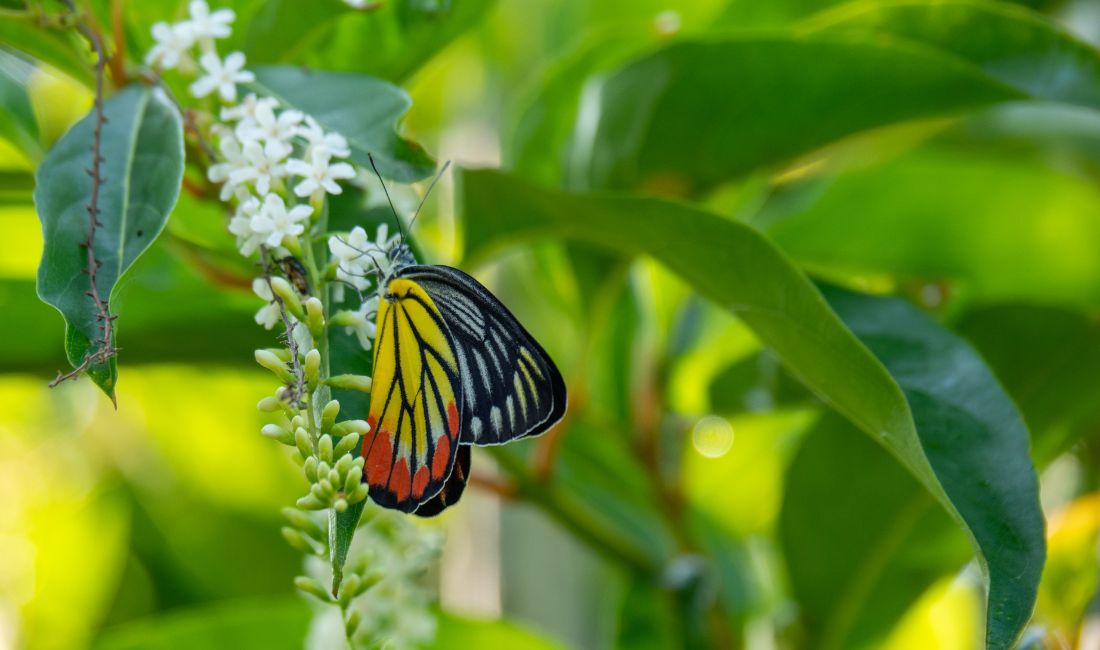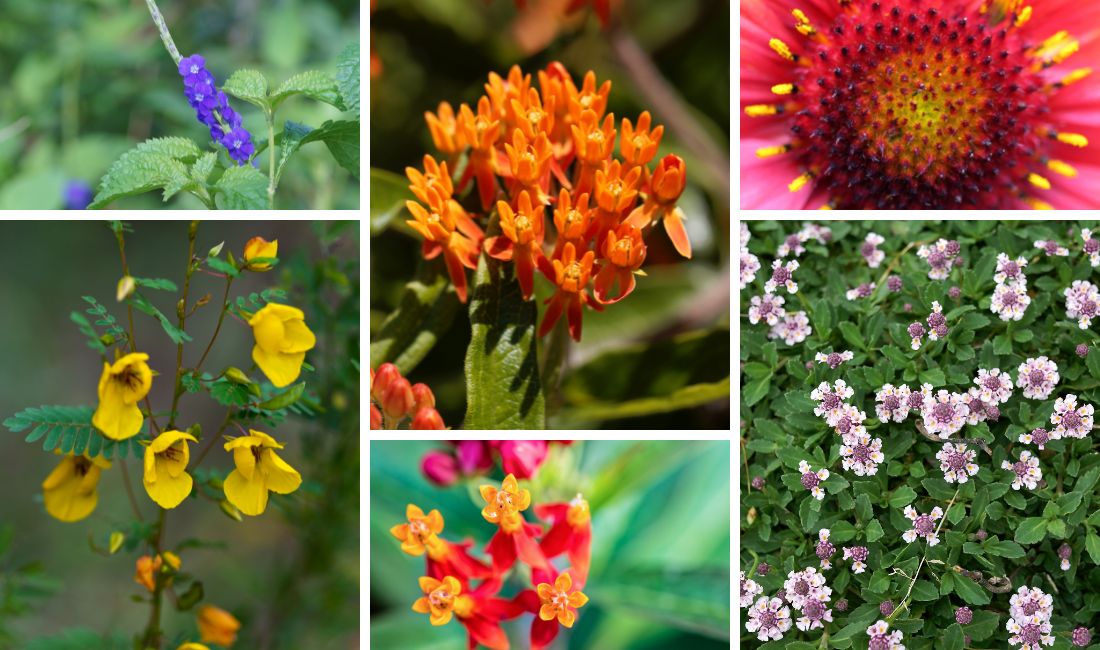You may have heard that invasive plants and trees are taking over native vegetation in the Palm Beach area. As a result, Palm Beach residents are now required to incorporate at least 35% native plants in any new landscaping. But what are the native plants that we are so concerned with protecting? And why is it so important?
In this article, we cover:
- What native plants are,
- Why native plants are important for your Palm Beach property,
- How to recognize our native plants,
- And how to incorporate native plants into your landscaping (without it looking like a wilderness area!).

Native plants such as the Citharexylum spinosum benefit pollinators
What are Native Plants?
Native plants:
- include trees, ferns, grasses, shrubs, vines, wildflowers, and other plants,
- have always grown in the area where they’re now found, and
- were not introduced from another area, whether that’s elsewhere in Florida, the USA, or around the world.
When you look up any plant, you’ll often find information about its “native range.” Anything growing outside of its native range is non-native.
Most palms, for instance, did not originally grow in Florida but were brought from other areas. Many of the plants that are now invasive in Palm Beach were introduced from other countries and have overtaken the plants and trees that were already growing here.
Plants introduced from other areas first appeared around the time of European settlement in North America. Since then, the number and variety of non-native plants in the USA have continued to grow. South Florida, with its warm weather and ample rain, has seen more than its fair share of invasive plants as people moving to the area brought with them plants and seeds of vegetation that easily grew in the places where they came from.
Why are Non-Native Plants a Problem?
Plants that are not native to South Florida can sometimes outgrow native plants, outcompete them for water, nutrients, and sunlight, and even kill our native flora.
In their native range, plants are often kept in check by insects and/or animals that eat parts of the plant or otherwise limit its growth. Areas with cold winters cause plants to go dormant (stop growing) or die off during the winter months. And in locations with less moisture, plants generally grow more slowly.
Without those checks in place, some non-native plants can become invasive; they spread rapidly and can cause immense harm to our local ecosystem.

A live oak tree, one of the native trees recommended for Palm Beach properties
How Native Plants Help Our Environment
Many people who replace non-native plants with native ones find that more birds and butterflies are attracted to their property. This is because our native wildlife depends on native plants for food, places to perch, shelter from the elements, and more.
The Palm Beach environment is a complex ecosystem where everything is interconnected. When one part of the system is damaged, it has a ripple effect that impacts many other parts.
Many insects, birds, and other animals require native plants as a food source. If there aren’t any native plants (or aren’t very many), then there won’t be many (or any) insects, birds, or other animals.
For example, many of our local pollinating insects do not pollinate non-native plants so a property with no native plants will have very few insects. Pollinating insects are an important food source for native birds, especially young birds. If there are no insects to feed on, there will be very few birds. Eventually, the lack of native plants can lead to the extinction of some of our birds, as well as the animals that feed on them.
Native plants are so important to the biodiversity of Palm Beach that there is now a requirement that 35% of new landscaping be made up of native plants.
Benefits of Native Plants
Installing native plants and trees in your Palm Beach landscape can reduce the amount of irrigation needed. Many of our native plants survive on only rainfall once they are established.
Each property’s soil is unique, but plants native to the area are more likely to thrive in your soil, often requiring less fertilizer. Using less fertilizer prevents runoff and results in less pollution in our waterways.
In most cases, native plants are easier to grow and cost less to maintain and keep healthy as compared to non-native plants.
You can learn more about the benefits of landscaping with native plants in this article from the National Audubon Society.
How to Recognize Native Plants
Knowing and recognizing South Florida’s native plants is the first step towards incorporating them into your Palm Beach landscape. Thankfully, there are many resources that can help you learn and appreciate our native flora.
Florida Native Plant Society
The Florida Native Plant Society has a wealth of resources available to the public, including this handout, Good Citizen Guide to Natural Florida, South Florida Region.
Palm Beach County Chapter of the Florida Native Plant Society
If you’re looking for something a bit more local, there is a Palm Beach County chapter of the FNPS. Their website has some helpful information, but the real benefit may be in the events that they host.
For instance, there is an ongoing monthly event that focuses on discovering and identifying South Florida native plants in their natural habitats.
There’s also a native plant demonstration garden in Mounts Botanical Garden, where a monthly garden maintenance event takes place, and a yearly Native Garden Tour, where you can visit a variety of native gardens throughout Palm Beach County. More information about these events and more is available on their website.
You can research our native plants online. See a list of over 300 native plants suitable for Palm Beach County, listed in alphabetical order by scientific name.
You can also search for native plants using your zip code and plant requirements (soil, sun requirements, salt tolerance, etc.).
Take a drive along one of these wildflower routes or visit wildflower hotspots to see native wildflowers when they are in bloom.
This pocket garden in Palm Beach contains only native plants and is worth a visit.
Once you can recognize and appreciate the beauty of our native plant life, you’ll want to incorporate many more native plants into your own landscaping.

Recommended plants for a South Florida butterfly garden are found in a variety of shapes and colors.
How to Use Native Plants on your Palm Beach Property
If you are creating new landscaping, remember that the Palm Beach Town Council passed a measure that requires all new landscaping to consist of at least 35% native plants.
The native plants that the Palm Beach Town Council refers to are based on the Natives For Your Neighborhood lists found by entering your zip code. Find which plants, trees, shrubs, vines, wildflowers and more are considered native in your neighborhood.
There are endless ways to add native plants to your property, but we’ve listed some ideas below.
Replace Some Lawn With a Butterfly Garden
This will help local pollinators bring some beautiful butterflies to your property, and reduce the water needed for the lawn.
Here are some suggested plants to create a South Florida butterfly garden from the North American Butterfly Association:
- Blue Porterweed (Stachytarpheta jamaicensis)
- Butterfly Milkweed (Asclepias tuberosa)
- Firewheel (Gaillarida pulchella)
- Partridge Pea (Chamaecrista fasciculata)
- Tropical Milkweed (Asclepias curassavica)
- Turkey Tangle Fogfruit (Phlya nodiflora)
- Water dropwort (Oxypolis filiformis)
Replace Invasive Plants With Native Plants
Instead of Chinese Tallow, plant Eastern Redbud or Red Mulberry
Instead of Brazilian Pepper Tree, plant a variety of native hollies
Find Native Alternatives
When adding a new plant or tree to your property, research native alternatives. Most non-native plants have a similar-looking native substitute.
Learn if one of the two native Banyan trees of South Florida is right for your property.
Coastal Gardens Can Assist You
The landscape professionals at Coastal Gardens can help you incorporate more native plants in your landscape. We can replace, install, or design your Palm Beach property using a mixture of local favorites and native plants or even create a beautiful garden using only plants indigenous to our area.
Our experienced Estate Gardeners are experts on native plants and can help you determine which ones would work best on your Palm Beach property.
Contact us today to learn more about our Landscape Installation and Landscape Enhancement Services.
CALL US TODAY At 561-308-7604
Estate landscape Services
For Fine Properties in Palm Beach
With Coastal Gardens, you can rest easy knowing that your property is taken care of by a dedicated team of estate landscape professionals who truly care about creating and maintaining a dazzling outdoor space you can be proud of.
